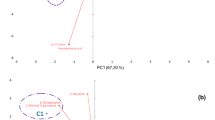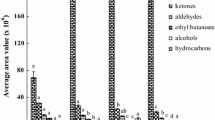Abstract
Levels of volatile compounds in Van herby cheeses manufactured from raw and pasteurized; 100 % ewes’, 50 % ewes’+50 % cows’ and mixture of 50 % ewes’+25 % cows’+25 % goats’ milks were investigated over 180 days of ripening at 4 °C. The volatile compounds levels of herby cheese samples increased throughout the 180 days storage period. Samples produced from pasteurized milk showed lower volatile contents than their counterparts produced from raw milk. The volatile compounds profile of herby cheese samples detected by headspace solid-phase microextraction (HS-SPME) consisted of 8 esters, 5 ketones, 5 aldehydes, 9 acids, 6 alcohols and 14 hydrocarbons and terpenes. Acetic acid was the most abundant volatile compound in HS-SPME of ripened cheeses, followed by hexanoic, octanoic and butanoic acids.
Similar content being viewed by others
References
Abilleira E, Renobales M, Najera AI, Virto M, Gordoba JCR, Perez-Elortondo FJ, Albisu M, Baron LJR (2010) An accurate quantitative method for the analysis of terpenes in milk fat by headspace solid-phase microextraction coupled to gas chromatography-mass spectrometry. Food Chem 120:1162–1169
Barron LJR, Redondo Y, Flanagan CE, Perez-Elortondo FJ, Albisu M, Najera AI, Renobales M, Fernandez-Garcia E (2005) Comparison of the volatile composition and sensory characteristics of Spanish PDO cheeses manufactured from ewes’ raw milk and animal rennet. Int Dairy J 15:371–382
Berard J, Bianhi F, Careri M, Chatel A, Mangia A, Musci M (2007) Characterization of the volatile fraction and of free fatty acids of “Fontina Valle d’Aosta”, a protected designation of origin Italian cheese. Food Chem 105:293–300
Beuvier E, Buchin S (2004) Raw milk cheeses. In: Fox PF, McSweeney PLH, Cogan TM, Guinee TP (eds) Cheese: chemistry, physics and microbiology vol. 1: general aspects, 3rd edn. Elsevier Academic Press, London, pp 319–345
Bintsis T, Robinson RK (2004) A study of the effects of adjunct cultures on the aroma compounds of Feta-type cheese. Food Chem 88:435–441
Coskun H (1998) Microbiological and biochemical changes in herby cheese during ripening. Nahrung 42:309–313
Coskun H, Ozturk B (2000) Vitamin C contents of some herbs used in Van herby cheese (Van Otlu Peyniri). Nahrung 5:379–380
Coskun H, Tuncturk Y (2000) The effect Allium sp. on the extension of lipolysis and proteolysis in Van herby cheese during maturation. Nahrung 1:52–55
Engels WJM, Dekker R, De Jong C, Neeter R, Visser S (1997) A comparative study of volatile compounds in the water-soluble fraction of various types of ripened cheese. Int Dairy J 7:255–263
Fernandez-Garcia E, Carbonell M, Nunez M (2002) Volatile fraction and sensory characteristics of Manchego cheese. 1. Comparison of raw and pasteurized milk cheese. J Dairy Res 69:579–593
Foda MI, Seleet FL, El-Ghorab AH (2008) Sensory evaluation and related volatile components of white herby cheese. Int J Dairy Sci 3:160–169
Fox PF, Law J, McSweeny PLH, Wallace JM (1993) Biochemistry of cheese ripening. In: Fox PF (ed) Cheese: chemistry physics and microbiology, 2nd edn. Chapman and Hall, London, pp 389–438
Frank DC, Owen CM, Patterson J (2004) Solid phase microextraction (SPME) combined with gas-chromatography and olfactometry-mass spectrometry for characterization of cheese aroma compound. Lebensm Wiss Technol 37:139–154
Gehrig RF, Knight SG (1963) Formation of ketones from fatty acids by spores of P. roqueforti. Nature 182:1237–1240
Ghoulami S, Idrissi AI, Fkih-Tetouani S (2001) Phytochemical study of Mentha longifolia of Moroco. Fitoterapia 72:596–598
Hayaloglu AA, Brechany EY, Deegan KC, McSweeney PLH (2008) Characterization of the chemistry, biochemistry and volatile profile of Küflü cheese, a mould-ripened variety. LWT Food Sci Technol 41:1323–1334
Javidipour I, Qian MC (2008) Volatile component change in whey protein concentrate during storage investigated by headspace solid-phase microextraction gas chromatography. Dairy Sci Technol 88:95–104
Law B (1984) Flavor development in cheeses. In: Davies FL, Law B (eds) Advances in the microbiology and biochemistry of cheese and fermented milk. Elsevier, New York, pp 187–208
Liu SQ, Holland R, Crow VL (2004) Esters and their biosynthesis in fermented dairy products: a review. Int Dairy J 14:923–945
Molimard P, Spinnler HE (1996) Compounds involved in the flavor of surface mold-ripened cheeses: origins and properties. J Dairy Sci 79:169–184
Munoz N, Ortigosa M, Torre P, Izco JM (2003) Free amino acids and volatile compounds in an ewe’s milk cheese as affected by seasonal and cheese-making plant variations. Food Chem 83:329–338
Negi PS (2012) Plant extract for the control of bacterial growth: efficacy, stability and safety issues for food application. Int J Food Microbiol 156:7–17
Ortigosa M, Torre P, Izco JM (2001) Effect of pasteurization of ewe’s milk and use of a native starter culture on the volatile components and sensory characteristics of Roncal cheese. J Dairy Sci 84:1320–1330
Rehman SU, Banks JM, Brechany EY, Muir DD, McSweeney PLH, Fox PF (2000) Influence of ripening temperature on the volatiles profile and flavor of Cheddar cheese made from raw or pasteurized milk. Int Dairy J 10:55–65
Rodriguez-Alonso P, Centeno JA, Grabal JI (2009) Comparison of the volatile profiles of Arzua-Ulloa and Tetilla cheeses manufactured from raw and pasteurized milk. LWT Food Sci Technol 42:1722–1728
SAS/STAT (2006) Software changes and enhancements through release 6.12. SAS Institute Inc, Cary
Tarakci Z, Coskun H, Tuncturk Y (2004) Some properties of fresh and ripened Herby cheese, a traditional variety produced in Turkey. Food Technol Biotechnol 42:47–50
Author information
Authors and Affiliations
Corresponding author
Rights and permissions
About this article
Cite this article
Ocak, E., Javidipour, I. & Tuncturk, Y. Volatile compounds of Van Herby cheeses produced with raw and pasteurized milks from different species. J Food Sci Technol 52, 4315–4323 (2015). https://doi.org/10.1007/s13197-014-1458-8
Revised:
Accepted:
Published:
Issue Date:
DOI: https://doi.org/10.1007/s13197-014-1458-8




